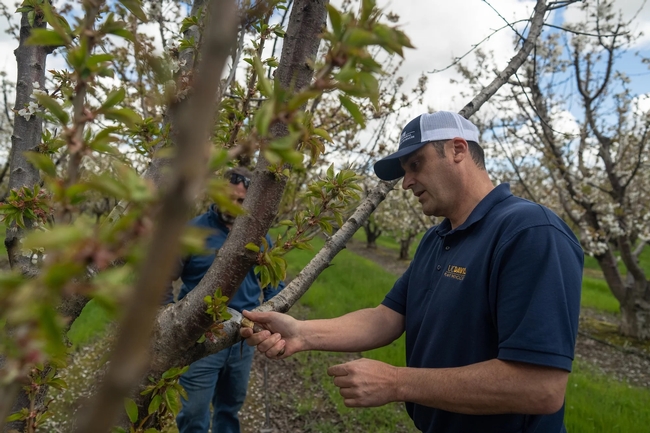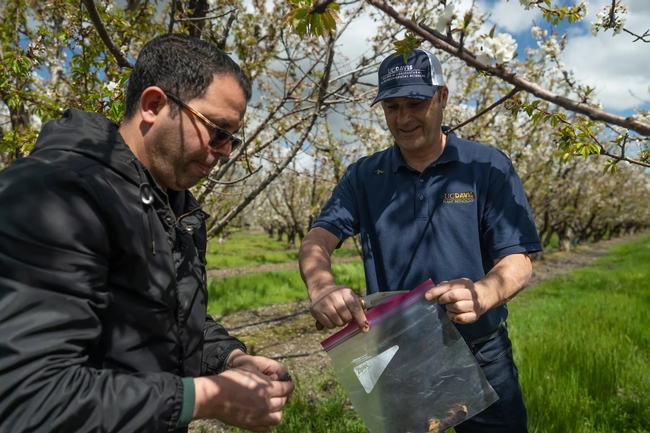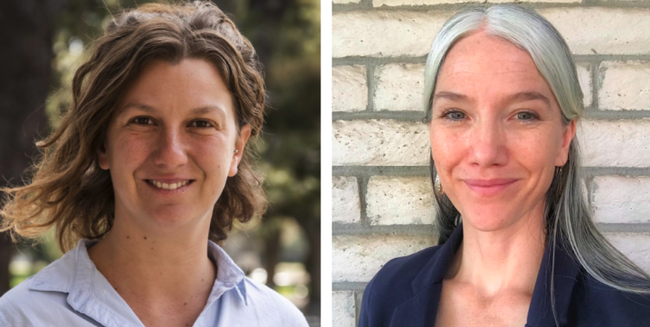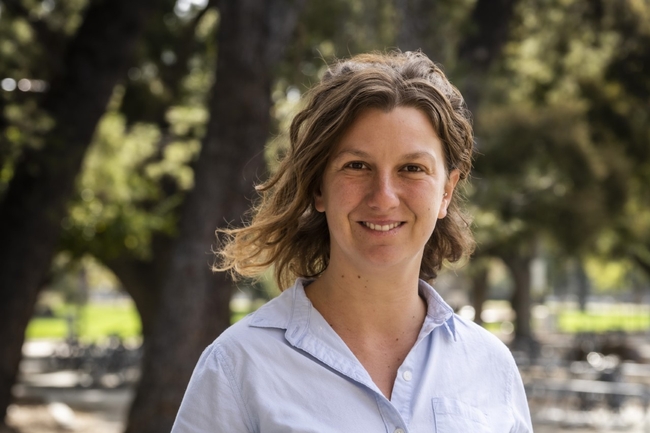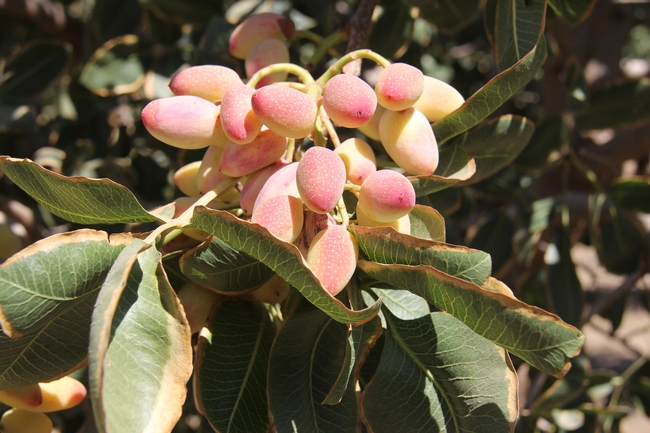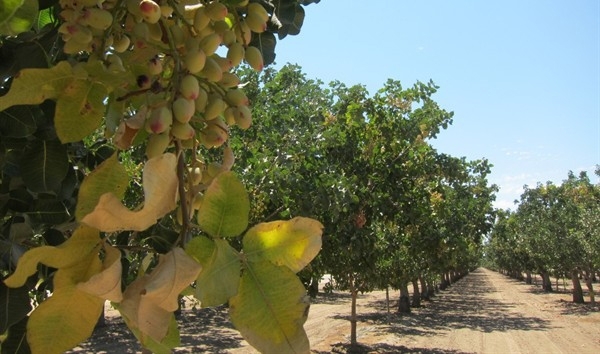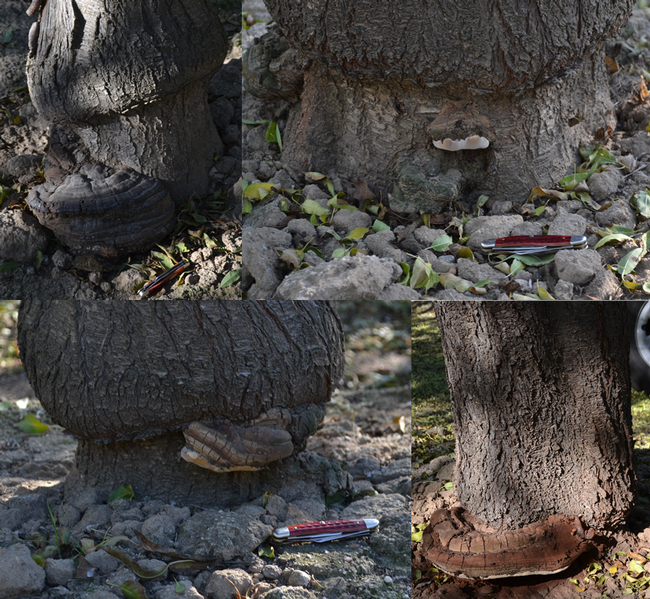Posts Tagged: Mae Culumber
Winter atmospheric rivers gave pathogens, diseases path to infect crops
Outbreaks similar to El Niño-influenced issues of the 1990s
The wave of atmospheric rivers that swept across the state this winter has created the right conditions for plant pathogens that haven't been seen for decades in California. University of California, Davis, plant pathologist Florent “Flo” Trouillas is getting more calls from growers and farm advisors concerned about potential crop damage.
“Generally, whenever you have rain events, you're going to have problems,” said Trouillas, a Cooperative Extension specialist who is based at the Kearney Agricultural Research and Extension Center in Parlier. “In wet years we get really busy because most pathogens need and like water.”
Trouillas is like a disease detective. He splits his time between the field and the lab, working to diagnose pathogens, diseases and other ailments that strike fruit and nut crops such as almonds, cherries, olives and pistachios.
On a recent visit to an almond orchard near Fresno, Trouillas joined Mae Culumber, a nut crops farm advisor for UC Cooperative Extension Fresno County. A few weeks earlier, the two had walked the orchard, taking note of the base of some trees that had gumming — a thick, jelly-looking substance indicating a pathogen had taken hold.
“A lot of what Florent is doing is trying to assess patterns on a landscape,” Culumber said. “Sometimes things may look like they are one thing, but it could be another problem.”
When the two returned weeks later, the amber-colored gumming had moved into the canopy, looking like gumballs stuck to branches, some of which were already dead. “It's getting out of control from before,” Trouillas says. “This branch was killed. This is widespread.”
From the field to the lab
Lab testing confirmed what Trouillas believed was the culprit: Phytophthora syringae, a pathogen that can affect almond crops but is rarely seen in California. If it is found, generally the site of infection are wounds caused by pruning, but that is not the case here, where the infection began in the canopy at twigs, or small branches.
It is a threat to a key crop, which according to the California Department of Food and Agriculture, generates $5 billion annually. The last time Phytophthora syringae hit California was in the 1990s after a series of El Niño-influenced storms. Trouillas, who has a photographic memory, remembered reading about it in an old manual.
“It's rare for California and one that we see mostly following atmospheric rivers,” he says.
“The disease will only happen following these extremely wet winters.”
Phytophthora is soilborne, mostly found in tree roots, and doesn't generally spread up into branches. But the intense storms created the right conditions for the pathogen to “swim” up trunks as winds blew spores into the air and rain dropped them back down into the canopy, Trouillas said.
Some of the trees in this orchard will die; others can be saved by pruning infected branches and applying a recommended fungicide, he said.
Identification, diagnosis, education
Trouillas is one of more than 50 Cooperative Extension specialists at UC Davis and each is charged with identifying problems and developing solutions for those issues in support of agriculture, the ecosystem and communities throughout the state.
In his role, Trouillas focuses not only on pathology and research but also on educating growers, nursery staff, pest control advisers and others in agriculture about ways to manage potential threats and how to prevent crop damage.
“His role is very crucial,” said Mohammad Yaghmour, an orchard systems advisor for UC Cooperative Extension Kern County. “He's not only on this mission to educate growers but he's also a source of education for us.”
Trouillas typically conducts one or two site visits a week, usually after a farm advisor reaches out about a problem they can't solve on their own.
“This allows us to be at the forefront of disease detections in California,” he said.
He likens these visits to house calls a doctor would make, only to fields instead. And one of those calls recently took him to a cherry orchard in Lodi.
“These guys help me quite a bit,” said Andrew Vignolo, a pest control adviser with Wilbur-Ellis who asked for a consult. “I bug them a lot.”
The visit starts like any consult in a doctor's office, only the questions come fast as they walk around the Lodi orchard where branches are dying, there is gumming and the trees appear stressed. Some look to be sunburned from exposure. Old pruning wounds show cankers, indicating that past disease treatments didn't get rid of whatever was affecting the trees.
Trouillas asks about the cultivar of the trees because some varieties are more susceptible to pests or diseases. He focuses on stress because that opens the door to disease.
Do they prune in the dormant winter months or in summer when pathogens are more prevalent? Does the soil get tested? How old are the trees? What about nutrition?
“I'm trying to figure out how they got infected so bad,” Trouillas said, walking the orchard. “Bacterial canker is a very mysterious disease.”
He thinks it might be a bacterial canker disease and shaves some bark to take to the lab for testing. He wants to come back next winter to take some samples to see where the pathogen is overwintering.
“We'll know in a few weeks if we have a fighting chance,” Vignolo said.
Be it Lodi, Fresno or elsewhere in the state, Trouillas focuses on local conditions. But what is learned in one field can be passed on to others, providing early warnings or advice for those in similar situations. “All these efforts at collaboration, from the field, to the lab, going through research projects, there's only one goal here — to help the farmers of California.”
UC ANR names Marino, Culumber Presidential Chairs for Tree Nuts
Two UC Cooperative Extension scientists have been selected as Presidential Chairs for Tree Nuts at University of California Agriculture and Natural Resources.
Giulia Marino, UCCE specialist, will be the Presidential Chair for Tree Nut Genetics and Mae Culumber, UCCE nut crops advisor, will be the Presidential Chair for Tree Nut Soil Science and Plant Water Relations, announced Glenda Humiston, UC vice president for agriculture and natural resources.
The endowed chairs will give the two scientists a dedicated source of funding for five years for their ongoing agricultural research. UC Agriculture and Natural Resources established the two $1 million endowments in 2015. Half of the funds for the endowed chairs was donated by the California Pistachio Research Board and the other half was provided by UC Office of the President.
“The California Pistachio Research Board appreciated the opportunity to create these Presidential Chairs with the dedicated flexible funding it provides the scientists,” said Bob Klein, manager of the California Pistachio Research Board. “Mae and Giulia have stellar research records, have a history of research on California pistachios, and deserved both consideration and the award of these Chairs. The Board was pleased with the previous incumbents and is now looking forward to working with both Giulia and Mae in their programs on Genetics and Soil Science/Water Relations.”
Marino, who joined UC ANR in 2020, is based at UC Kearney Agricultural Research & Extension Center in Parlier. Her research integrates germplasm preservation and evaluation with tree physiology to improve orchard system profitability and abiotic-stress resilience. She explores the interactions between cultivar-rootstock traits, soil conditions and management practices.
“The program has the objectives of increasing the genetic diversity of the scion and rootstock cultivars used by the pistachio industry to improve grower returns and reduce its susceptibility to climate change,” Marino continued. “Rootstock projects include novel rootstocks more tolerant of boron in irrigation water, dwarfing rootstocks for higher early yields and more efficient use of pruning and harvest inputs. Scion objectives include novel scions for higher yield and trees less sensitive to inadequate winter chilling.”
One of her current research lines focuses on the characterization of low vigor cultivars and/or rootstocks to increase orchard planting density and reduce management costs in olive, pistachio and almond. She develops protocols for irrigation management based on genotype-specific physiological responses to water stress. Marino also studies the impact of saline sodic soil conditions on pistachio physiology and of low winter chill on cherry and pistachio tree and fruit physiology.
Marino earned a doctoral degree in fruit and forestry tree systems and master's and bachelor's degrees in agricultural science, all from the University of Palermo in Italy.
Culumber, UCCE nut crops advisor for Fresno and Kings counties, focuses on enhancing the sustainability and viability of nut crop production through applied research and outreach education with emphasis on soil and water conservation and reducing the impact of production practices on air quality and greenhouse gas emissions. Culumber partners with fellow UC advisors, specialists, campus faculty, growers and other industry stakeholders to find practical, sustainable solutions for issues including soil salinity, tree training and pruning, tree nutrition, and pest and disease management.
“As Presidential Chair, I will utilize these generous funds from the Pistachio Research Board to augment my collaborative outreach extension and applied research efforts to understand
and develop solutions to soil and water quality problems faced by pistachio growers and other nut crop producers across the San Joaquin Valley,” Culumber said.
She is collaborating on a CDFA Fertilizer Research and Education Program project that provides irrigation and nitrogen management training for certified crop advisors and growers to adopt practices that conserve water and protect water quality. She is also studying how to improve estimates of crop evapotranspiration and forecasting for major California crops for more precise irrigation. Culumber is leading research on the effects of whole orchard recycling on air quality and climate resilience, soil health, tree growth and productivity in second-generation orchards.
Culumber earned a Ph.D. in soil science and agroecology and a master's in plant science and molecular ecology, both from Utah State University, and a bachelor's in biology from University of Wisconsin-Stevens Point.
Bruce D. Lampinen, UC Cooperative Extension integrated orchard management, walnut and almond specialist in the UC Davis Department of Plant Sciences, received the first Presidential Chair for Tree Nut Soil Science and Plant Water Relations. Craig Kallsen, UC Cooperative Extension farm advisor in Kern County who specializes in fruit and nut crops, received the Presidential Chair for Tree Nut Genetics.
Climate and California agriculture of the future
One of the forces driving agricultural experiments in California's fertile San Joaquin Valley is climate change, reported Mark Schapiro on Grist.org. Although some sources still don't feel completely comfortable with the concept.
"Whether it's carbon built up in the atmosphere or just friggin' bad luck, the conditions are straining us," said John Duarte, president of Duarte Nursery.
The state's fruit and nut orchards are taking the most heat as conditions change. A fruit or nut tree planted today may be ill-suited to climatic conditions by the time it begins bearing fruit in 5 or 10 years. Between 1950 and 2009, “chill” hours trees needed annually to reboot trees' metabolic system for the spring bloom had already declined by as much as 30 percent, according to a California Department of Food and Agriculture study.
“If trees haven't had that low-chill period when they wake up in the spring, it's like being up all night and then trying to go to work.” said Mae Culumber, a nut crop advisor with UC Cooperative Extension in Fresno County.
Researchers have already observed that cherry, apricot, pear, apple, pecan and almond trees are often less productive than they used to be.
The article said farmers may turn to pistachio trees to weather a warmer and dryer California. Pistachio trees require one-third to one-half as much water as almond trees. During droughts, pistachio tree metabolism slows and when water returns, they start producing nuts again. And they can produce nuts for 80 years or longer, almost four times the life span of an average almond tree.
For field crops, scientists are looking at improving the soil and transforming growing systems to help farmers adapt to the warming climate.
“When I drive to the Central Valley, I get goosebumps; I feel the urgency,” UC Davis agronomist Amélie Gaudin said. “I see an agriculture that is basically hydroponics. It's like a person being fed/kept alive by an IV.”
“What happens when you no longer have the sugar-water?” she adds.
Gaudin is focusing on using agroecological principles to develop efficient and resilient cropping systems. Planting cover crops and reducing tillage show promise for mitigating the impact of climate change in the valley.
A foreboding fungus is threatening orchards in the San Joaquin Valley
When an almond tree keels over in a mature orchard, it could be a sign of something ominous. UC scientists are tracking a fungal infection in San Joaquin Valley almond trees that can cost farmers hundreds of thousands of dollars in lost production.
“Ganoderma's been around for a long time,” said Bob Johnson, a UC Davis graduate student who is leading the study for his doctoral thesis under the direction of UC Davis plant pathologist Dave Rizzo. “The tree failure we're seeing may be that we've now reached such a density of almonds here, that the problem just seems more widespread. Or it may be a new Ganoderma species in our state.”
The UC Cooperative Extension nut crops advisor in Fresno County, Mae Culumber, speculated that air quality regulations prohibiting the burning of orchard prunings may have allowed fungi to grow in slash piles in agricultural areas. However, the cause of the problem is currently unknown.
Ganoderma is a genus of fungi with about 80 known species. It is typically considered a forest pest in the U.S. and, in terms of agriculture, poses problems for the palm tree industry in the tropics. The Ganoderma now being found in California agriculture grows in the living heartwood of almond, peach and other stone fruit trees. The presence of the fungus doesn't appear to impact tree production. The only outward sign is development of rather large shelf-like mushrooms on the trunks called conks.
“Once you see conks on the tree, it is essentially dying from the inside out,” Johnson said. “The conks release trillions of spores which wind and water move through the orchard and to neighboring orchards. It's next to impossible to stop the spread.”
A farmer in Hanford recently pulled out and destroyed every tree in his 120-acre orchard because of Ganoderma infection.
“This was a 9- or 10-year-old orchard, just when the grower starts making money after investing in its establishment,” Johnson said. “Instead, his trees were just falling down right and left and he pulled out the orchard.”
Culumber called Johnson out to a Fresno County orchard where the farmer is starting to lose trees.
“In his orchard, every fifth tree has a massively sporulating conk,” Johnson said. “Growers see the conks, but they don't realize they are the infectious part of Ganoderma fungi.”
Culumber said other orchards in the area also have active conks.
“I know of at least two locations within a square mile,” she said. “One is very progressed, and I talked with another grower with early symptoms.”
Johnson is calling on farmers to contact him if their trees have fallen over due to decay in the trunk or if they have seen conks on tree trunks.
“We need to understand the distribution and incidence of Ganoderma infection in order to develop management strategies that will limit the impact of this disease,” Johnson said.
To report trees potentially infected with Ganoderma, contact Johnson at (530) 302-6301 or bobjohnson@ucdavis.edu.

